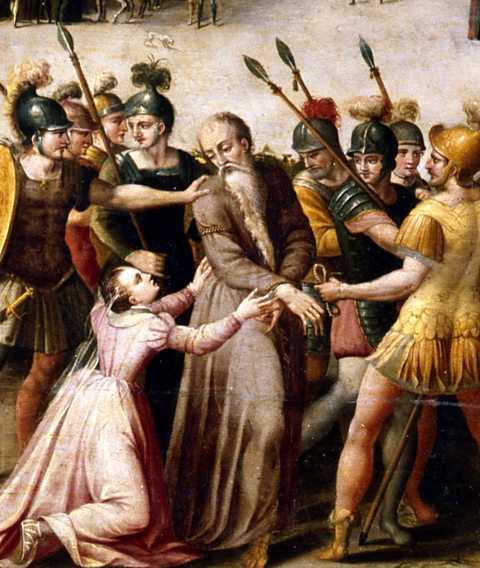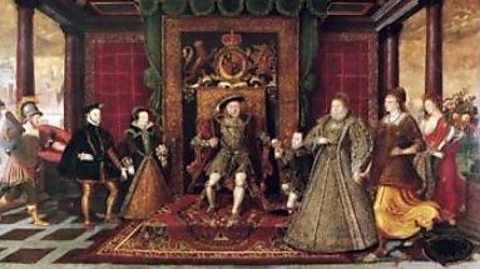A hard life
Life in Tudor England was hard and you had to be tough and lucky to survive. There was a very high infant mortality rate, around 14 percent died before their first birthday, and women had a shorter life expectancy than men due to the risks posed by childbirth.
So even reaching adulthood was an achievement and those who lived to their 40th birthday were considered to have arrived at old age.
Disease, starvation and punishment were all risks faced in daily life. So what skills would you have needed to survive in Tudor England?

Stay out of trouble
There was no police force in Tudor England. However those caught breaking the law were often severely punished. Crimes ranging from murder to the seemingly pettier theft of items worth more than 5 pence could result in execution.
Henry VIII's reign was particularly bloody and estimates of the number of executions range from 54,000 to 72,000. The method of execution also varied. Robbers were hanged and women who were alleged to have poisoned their husbands were burned. Those who committed treason faced a particularly brutal end, being hanged, drawn and quartered. Henry even executed two of his wives and some of his most trusted advisers.
Thought crimes
After Henry VIII split from Rome he made himself head of the English Church and passed the 1534 Treason Act. It became a potentially fatal act to deny Henry was head of the Church, wish him or the queen harm or suggest that he was either a heretic or a tyrant. The people of England now had to watch very carefully what they wrote or said about the king in public.
Religious loophole
Priests who were accused of crimes could claim the 'Benefit of Clergy'. This meant they would be tried in a Christian court under canon law and never face the death penalty. However, Henry clamped down on this by restricting the types of crimes that could go before church courts. No one was safe.

Escape the plague
Tudor England was rife with contagious diseases and regular epidemics of dysentery, tuberculosis and influenza swept through the country. Although they killed off rich and poor alike, the malnourished masses were less able to fight off infection and more prone to death by disease.
Sweating sickness
One of the most feared was the sweating sickness, a mystery summer illness that could dispose of its victims within 24 hours. Sufferers apparently died sweating to death. Anne Boleyn survived the condition but Henry VIII's chief minister Thomas Cromwell lost his wife and daughters to the sweating sickness. Henry developed a deep fear of contracting the disease, breaking up the court and moving whole residences to try and avoid it.
God's judgement
The Tudors saw disease as a punishment from God. They understood that some, like the plague, could be spread by human contact, but had few effective treatments. This is because they believed the human body produced four bodily fluids known as 'the humors': blood, yellow bile, black bile and phlegm. They believed that illness was caused when these four went out of balance, so herbal remedies were made to try and restore the balance.
Dirty linen
Disease prevention also affected a Tudor person's personal hygiene. It was believed water could infect people through their pores so they cleaned their bodies by rubbing them with linen and cleaned their hair by combing it daily.
Ruth Goodman explains how the Tudors used herbs to ward off diseases. Clip from Tudor Monastery Farm (91Čȱ¬ Two, 2014)
Tom Pinfold: Right, where do you want your mats?
Ruth Goodman: Oh, yeah, stick them out the way for a minute, 'cos I've got the hygiene to sort out first. OK. I've got a whole load of herbs to scatter on the floor.
And they serve two basic functions. The first thing is about smell - people in this period believed that disease was carried by evil miasmas, by bad smells in the air.
And, if you breathed that evil miasma, you would get sick. So, wherever you lived, wherever you were spending time, you wanted it to smell as sweet and clean as possible.
But then there's also a role for insecticides - things like my tansy, my wormwood, fleabane. They're for keeping insects out of the house, things like flies or ants or, or body lice, fleas.
Anything like that can be driven out. And it will make the whole living experience, not only healthier, but much pleasanter.
Store up supplies for winter
The Tudor diet was tied to the seasons. People preserved as much food as possible for the hard months following the harvest, by drying meat, storing grain and making cheese. The poor were at risk of starvation following a bad harvest.
Daily bread
Almost 80 percent of a person's calorie intake came from grain – mostly beer, bread and pottage, a thick soup. The grain for these products was stored in bins and barns. The weak ale had the added advantage of being safer to drink than water. But people also needed back up food sources to cope with bad harvests.
'White meat'
In early Tudor times dairy produce such as butter and cheese were known as 'white meat' and were an important source of protein. Milk had limited use as it would not keep for long and was only drunk by the elderly and children.
Salting, smoking and pickling
Meat was salted or smoked to preserve it through the winter months but it was a luxury many couldn't afford. Instead they relied on vegetables such as onions, cabbages and kale. Potatoes only reached English shores in the 1580s.
Both rich and poor ate fish, but while the wealthy could have fresh fish, the poor who lived far from the sea relied on fish that was preserved by salting, drying or pickling.
Ruth Goodman explains how the Tudors made 'white meat'. Clip from Tudor Monastery Farm (91Čȱ¬ Two, 2014)
Store up supplies for winter
Ruth Goodman: Now, the reason I've transferred my milk into these dishes is to help the cream separate.
Look, see how thick that cream is. Super thick, look at that.
Lid on to minimise splashing.
Hear that? Knowing what stage you're at is all about listening to the sounds that it makes in the churn. And now it's all a matter of time. A volume of cream like this can turn into butter in as little as 15 to 20 minutes.
After all, everyone had a cow. The point was you could graze a cow even if you had no land yourself, you could graze it on the common land, you had a right to put a cow on the common, which meant that you had access to some milk.
You could make your own butter, you could make your own cream, you could make your own cheese. White meats, therefore, were a very democratic food, everybody had them. And the rich sneered.
Oh, yes, look at that. Now that looks good. There we are, look, butter.
The power of prayer
Religious belief and prayer provided people in Tudor England with hope and comfort in challenging times.
Look to the saints
Before the Reformation in England people prayed to different saints for help and healing. Those worried about the plague turned to St Sebastian, St Erasmus was thought to help with stomach illnesses while St Apollonia was believed to help in cases of toothache. The sick and injured would also travel to healing shrines and remain there for days, in the hope of a cure. Although Henry VIII brought in religious reform that outlawed these pilgrimages and banned the lighting of candles before images of the saints, some people still practised these rituals behind closed doors.
Use magic stones
People in Tudor times still turned to magic and superstition to protect them from harm. Amulets were worn to ward off danger. Precious stones, coloured cloth and parts of animals were thought to protect the owner against disease.
Professor Ronald Hutton talks about the significance of Palm Sunday celebrations in Tudor England. Clip from Tudor Monastery Farm (91Čȱ¬ Two, 2014)
Professor Ronald Hutton: The truly wonderful thing about Palm Sunday ritual is you get three things in one. You get people reminded of what the Christian message and the Christian story is all about. You get the greenery, which symbolises spring and hope and new life, and you get something which is actually going to protect your house and your family and your farm.
And all this in one symbolised in this procession with a layman - that's Peter up there, dressed up as a prophet - to dress this up as fun, to make it something people can engage in and which they can make their own.
It's just a totally brilliant way of giving religion to the people and enabling them to share in it. The truly insanely wonderful thing about Palm Sunday ritual is that it ended in a kind of spring version of a snowball fight.
And it's a wonderful example of the way in which religion round about 1500 introduced an element of just sheer merrymaking at the end of something solemn and profound, to remind us that we're alive and being alive means having fun.
This is the last ritual of Palm Sunday, but it's a really important one. It's where we take the crosses woven out of our consecrated greenery and put them over the doorway of your home to protect it for the next year against witchcraft, curses, demons and general misfortune. It's the ultimate security system circa 1500. Does it work? Apparently so, England is still here.
Learn more about this topic:
How did Henry VIII use sex and power to secure his legacy? document
This interactive guide explores the lives of Henry VIII, Anne Boleyn and Thomas Cromwell, and looks at how they shaped Tudor England.

What did King Henry VIII really want from a wife? document
What did the Tudor king Henry VIII want from his six wives? And why would he execute them, like Anne Boleyn, or divorce them, like Catherine of Aragon?

The story of Black migrants in England in Tudor times. video
A short film, presented by David Olusoga, which explores the lives of some of the hundreds of Black migrants who were in England during the Tudor period.
